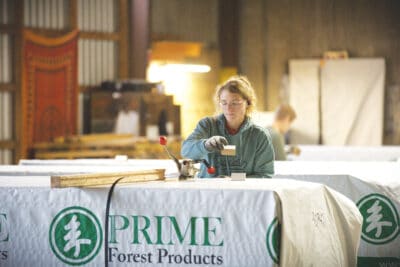In the Midwest region, one lumberman expressed pure positivity about the market while others said great sales activity may not be happening at this time, but it is coming.
A sawmill representative in Texas stated, “The market is good.” Asked what made him say that, he observed, “The board market is still strong.” His company manufactures all Southern Yellow Pine in grades No. 2 and No. 3 and D and Better in one-inch thickness. “We produce 17 different patterns,” he added.
The market was better at the time of the interview than it had been several months earlier, he remarked.
He sells mainly to wholesalers, he said, and to “very few end users.” His customers are struggling in that it is hard for them to find the materials that they need, he stated.
For this sawmill, transportation is a problem. “It’s hard to find trucks,” he said. “We don’t use rail.”
A wholesaler in South Dakota said, “The market is steady. It’s busy. There are a lot of people with projects lined up and ready to go but it’s a matter of getting going with the change of seasons. More sales are coming but it takes time.”
Asked if things are better or worse in the market than several months ago, he commented, “I wouldn’t say ‘either’ ‘or.’ Things are holding pace right now.”
In Softwood, he sells mainly Cedar, followed by SPF, Hem Fir and a little bit of Doug Fir.
He sells to lumberyards. “A lot of them are busy,” he observed. “Customers are bidding a lot and have a lot of jobs in the works. They are waiting for people to dig holes, pour concrete and such for construction.”
Transportation is difficult in that “it’s taking forever to get materials in,” he noted. “We’ve got plenty of materials out there to buy; we just can’t seem to get it in a timely fashion. We get lumber by truck and rail, and we ship it out by truck. Truck and rail are both problematic.”
A wholesale distributor in Kansas City stated that his market is “still strong. I think the pricing got to a level where there’s been some pushback. People are kind of taking a wait-and-see approach to the market. There’s been some correction in Softwood lumber. Whenever these guys sense a little blood in the water and the prices going down, they kind of pull back in their buying a little bit.
“Overall,” he said, “the demand is still strong with the builders, but I do sense a slight pullback in buying till the price levels out. Everyone’s trying to catch that bottom of the market; they want to buy at the absolute cheapest point. So, unless they’re out of inventory, they’ll wait this out until they sense we’re at the bottom of the correction.
“When the market is accelerating upwards in price,” he observed, “our customers will buy lumber off of railcars that aren’t here yet, because they know it’s an investment. It’ll be worth more when it gets here. When it’s going down, they do the opposite; they do not want to buy off of long lead-times; they want to get prompt wood only. People are holding off a bit, to see where the market lands on pricing.”
Compared to a few months earlier, he noted that the market was “about the same.”
He handles No. 2 SPF, No. 2 green Doug Fir and Western Red Cedar. The best seller is green Doug Fir. “We sell primarily to pro dealer yards and big box stores,” he noted. “Sales are still great at the dealers’ yards. There’s no sense of pullback except for the pricing issue. The general dynamics are still good. There’s still more people trying to buy houses than there are houses available. So, they keep building them, creating demand.”
For him, transportation is a definite issue. “There’s still a rail-car shortage on cars out of Canada, and trucking is still very tough out of the west coast and Canada,” he remarked. “The two avenues we buy on are rail cars and to a lesser extent trucking, and both are difficult right now.”









